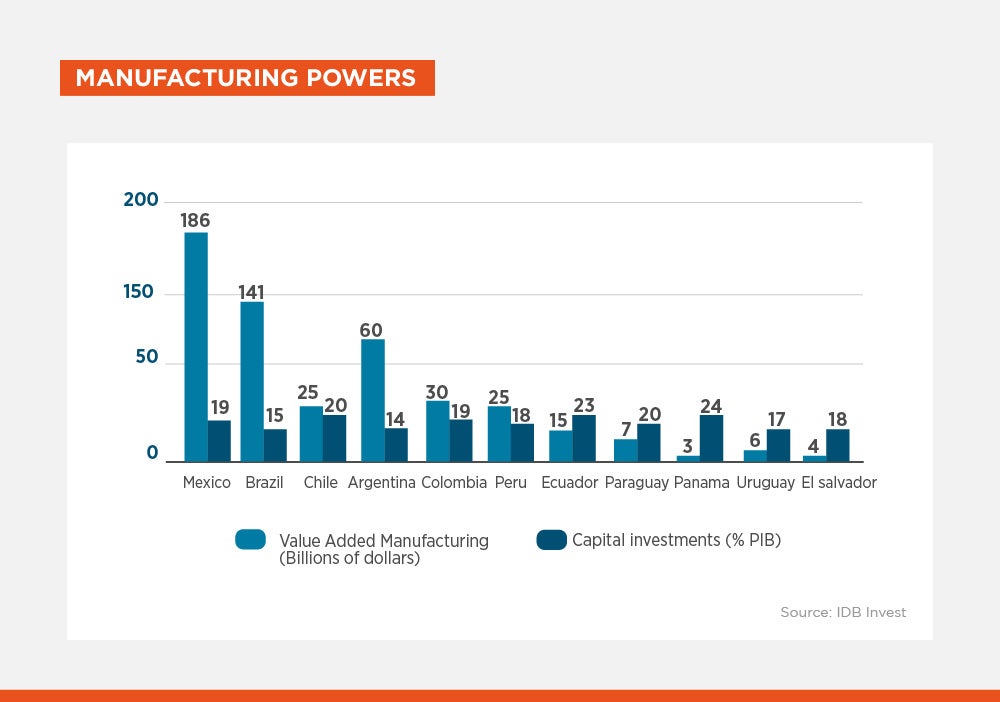How to Promote the Digital Transformation of Manufacturing in Latin America and the Caribbean

When it comes to addressing the much-needed digital transformation of the manufacturing sector in Latin America and the Caribbean (LAC), the first two steps are evident: (I) understanding what digital transformation in manufacturing is and (ii) asking the sector’s entrepreneurs and players about their needs and how digital technologies are helping them to meet those needs. The answers will surprise you.
The manufacturing sector accounts for almost 16% of the region's GDP and 20% of employment, being the livelihood of millions of families. Digitalization is both an urgent and delicate matter, as approaches and conditions vary depending on the country.
To get a clearer picture of the situation and assess the maturity level of the industries involved in different sub-sectors —from electronics to automotive— we have conducted a comprehensive study that also includes some transportation and retail companies playing an important role in distributing products to customers and end consumers.
Specifically in the manufacturing sector, the sample of 35 companies includes organizations from the textile, chemical, plastics, paper and by-products, non-metallic mineral products, fabricated metal products, machinery, electrical and electronic appliances, and automotive sub-sectors. There are companies from the seven countries leading the sector in LAC: Mexico, Brazil, Argentina, Colombia, Peru, Chile and Ecuador.
Each company was requested to make a self-assessment of their digital maturity, followed by interviews with business executives, five start-up leaders and six suppliers of the companies participating in the study.
One of the key findings is little known to the general public: redesigning the supply chains of large multinational companies is a main factor underscoring the need to accelerate the digital transformation, as they have plans to relocate much of their production capacity currently installed in Asia.
To attract the investment needed to finance the relocation plans, the LAC manufacturing sector needs to use digitalization as a lever to increase its competitiveness. The benefits from technologies, such as automation, the use of sensors and artificial intelligence algorithms, will significantly boost productivity.
Other technologies such as “digital twins” —accurate virtual models of a physical object that need to enter an experimentation phase before manufacturing— and additive manufacturing —a process that allows heavy metal parts to be replaced with lightweight but durable plastic parts— have shown great potential to optimize the use of resources and an ability to test enhancements more rapidly.
The Industrial Internet of Things (IIOT, the production of equipment that can be connected to the cloud, such as industrial robots and cranes) and advanced analytics models also enable improvements in productivity and process efficiency with a cross-cutting view of the entire value chain.
The results of the assessment indicate that the maturity level of the manufacturing sector in LAC is intermediate, with a rating of 2.97 on a scale of 5, partly due to advances in the production links driven by automation in the countries participating in the study.

Today, the main advances in the manufacturing sector consist in the presence of transformational plans that, in 74% of the surveyed companies, are not known by the entire organization, revealing an area of opportunity to place digital transformation on their strategic agenda.
Along with advances, there are opportunities that need to be taken to remain competitive, including more investment in the integration of new digital solutions that offer process automation and artificial intelligence capabilities and leverage larger amounts of real-time data to gather insights for decision making.
Digital transformation can also help companies to speed up their environmental, social and governance (ESG) agendas. In addition to increasing productivity and efficiency, this becomes even more relevant when considering challenges, such as climate change, and the need for increased participation of underrepresented groups in the sector, such as women.
To conclude, digital transformation is here to stay, and IDB Invest will support companies in this process.
LIKE WHAT YOU JUST READ?
Subscribe to our mailing list to stay informed on the latest IDB Invest news, blog posts, upcoming events, and to learn more about specific areas of interest.
Subscribe


